Introduction
Ayodhya, a city steeped in ancient history and revered as the birthplace of Lord Rama, holds a special place in the hearts of millions of Hindus. Its significance transcends time, embodying cultural, religious, and historical importance. At the heart of Ayodhya’s cultural landscape stands the Ram Mandir, a symbol of devotion and architectural splendor that weaves together the threads of mythology and faith.
Historical Background of Ayodhya
Ayodhya, one of the oldest continuously inhabited cities in the world, finds mention in Hindu scriptures such as the Ramayana. It is believed to have been founded by the legendary King Manu, with Ayodhya serving as the capital of the ancient Kosala Kingdom. Over the centuries, Ayodhya became synonymous with righteousness and virtue, an embodiment of the ideal city in Hindu tradition.
The city’s historical tapestry includes the reign of illustrious kings like Dasharatha and the revered presence of sages and saints. The significance of Ayodhya in Hindu culture is further accentuated by its association with the great epic, the Ramayana, where Lord Rama, the seventh incarnation of Lord Vishnu, was born.
Importance of the Ram Mandir in Hindu Culture and Mythology
The Ram Mandir stands as a testament to the enduring cultural and religious fabric of Ayodhya. For Hindus, it holds profound significance as the birthplace of Lord Rama, the epitome of dharma (righteousness) and a revered figure in Hindu mythology. The construction of the Ram Mandir is not merely an architectural endeavor; it represents the fulfillment of a longstanding dream, a revival of faith, and a reconnection with a cherished past.

The temple’s significance is deeply rooted in the Ramayana, where Lord Rama’s life, teachings, and divine exploits are chronicled. Devotees believe that the very spot where the Ram Mandir now stands is the exact location of Rama’s birth. Pilgrims from across the globe embark on a spiritual journey to Ayodhya to pay homage to this sacred site, seeking blessings and spiritual solace.
In Hindu culture, the Ram Mandir is not just a place of worship; it serves as a cultural repository, preserving and propagating the ideals exemplified by Lord Rama. The temple’s construction is a reclamation of cultural heritage and a reflection of the enduring connection between mythology and the contemporary religious landscape.
As the Ram Mandir continues to stand tall in Ayodhya, it symbolizes the eternal values of righteousness, devotion, and the unwavering faith of millions, making it a beacon of spiritual light in the heart of India.
If you want to know about the Types of slabs or Permeable concrete or Islamic architecture, please click the link.
1) Historical Evolution of Ayodhya Ram Mandir
Ancient Times: The origins of the Ayodhya Ram Mandir can be traced back to ancient times, with its roots deeply embedded in Hindu mythology and scriptures. According to the Ramayana, Ayodhya was the birthplace of Lord Rama, and over the centuries, a reverence for this sacred site grew among the Hindu faithful.
Medieval Period: The temple’s history took a significant turn during the medieval period when, according to historical accounts, a grand temple dedicated to Lord Rama was constructed at the birthplace in Ayodhya. This period marked the zenith of Ayodhya’s cultural and religious prominence.
Destruction and the Mughal Era: The temple faced a tumultuous phase during the Mughal era. In the 16th century, Babur, the first Mughal emperor, is said to have ordered the destruction of the existing temple. The controversial Babri Masjid was subsequently built on the same site in the 16th century, leading to centuries of dispute and tension.
Modern Period: The modern history of the Ayodhya Ram Mandir is characterized by legal battles, socio-political movements, and a quest for reclaiming the sacred land. The Babri Masjid-Ram Janmabhoomi dispute became a focal point of religious and political debates.
Demolition and Aftermath (1992): In 1992, the Babri Masjid was demolished by a group of activists, leading to nationwide repercussions. The incident intensified the communal divide and triggered legal proceedings to decide the fate of the disputed site.
Legal Battles and Resolution: The legal battles that ensued spanned several decades, with the Supreme Court of India finally delivering a landmark verdict in 2019. The judgment paved the way for the construction of the Ram Mandir at the disputed site, acknowledging the historical and religious significance of the birthplace of Lord Rama.
Reconstruction (Present Day): In the present day, the reconstruction of the Ayodhya Ram Mandir is a historic endeavor undertaken by the government and various stakeholders. The temple’s design and construction incorporate traditional architectural elements, echoing the grandeur of the original structure while symbolizing a revival of cultural and religious heritage.
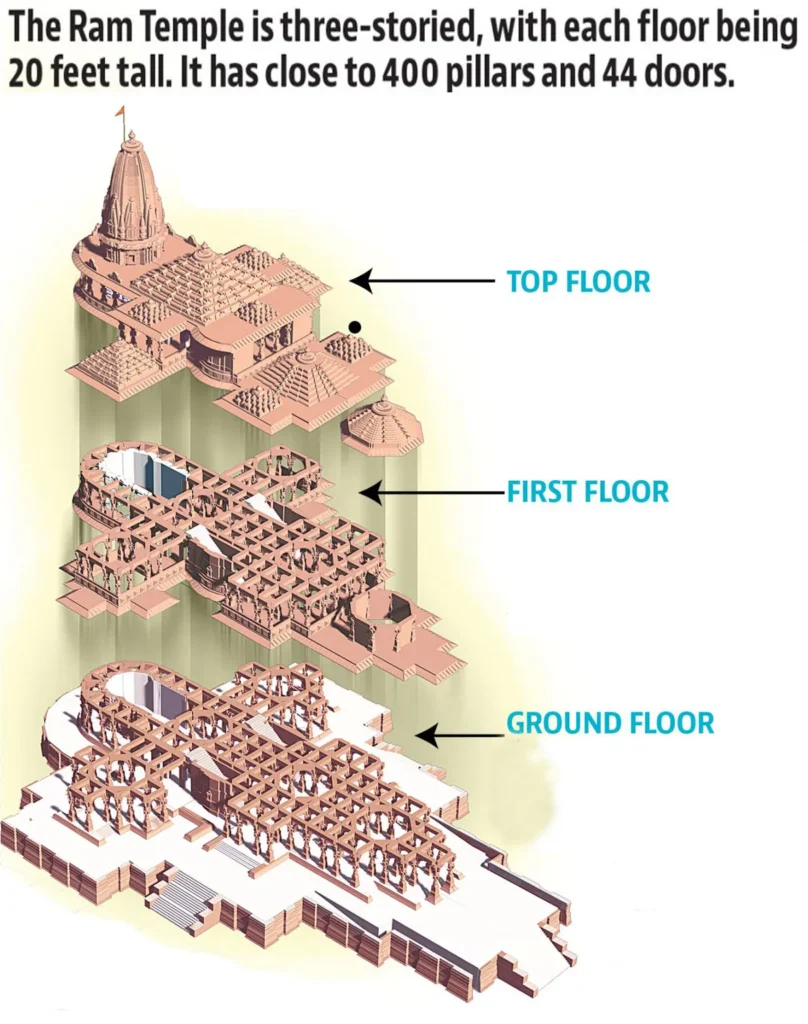
The Ayodhya Ram Mandir stands as a testament to the resilience of faith, the power of legal justice, and the historical continuity of a sacred site that has witnessed centuries of transformation. Its journey, from ancient times to the present day, reflects the complex interplay of history, religion, and contemporary socio-political dynamics.
2) Ram Mandir at Ayodhya
The proposed temple area is situated on the banks of River Sarayu (Approximately 1km from the riverbank). The temple is designed by a specialist Architect Consultant, as a Traditional structure, in a Nagara style of Temple architecture. The Parkota around the boundary of the temple will have temples of 06 Nos. Gods and Goddesses.
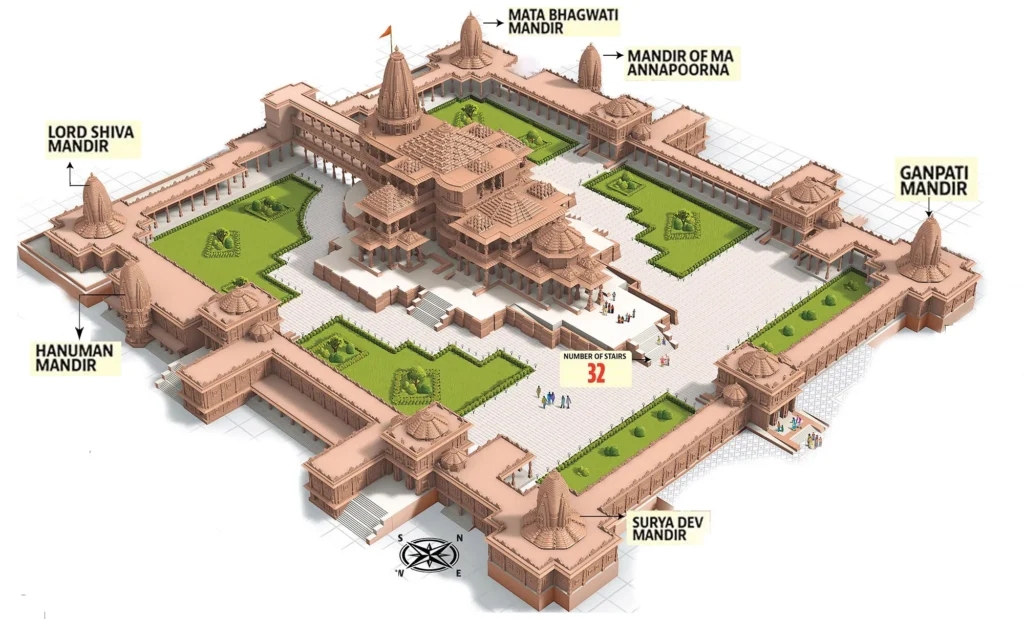
The Temple structure shall be integrated with the Shri Ram Janmbhoomi Complex Master plan. The temple will be constructed using traditional stone made up of sandstone, Granite, Mirzapur stone and Makrana Marble for flooring and cladding.
The structural elements are joined together by tongue and groove joints with copper pins and strip. Its dimensions are approx. 380×250 feet. The main Shikhara over Garbhagriha is 161 feet high. Finalization of Structural Stability analysis & Integrated Structural analysis by M/s L&T, TCE, Architect and CBRI Roorkee.
Main Temple Proportions
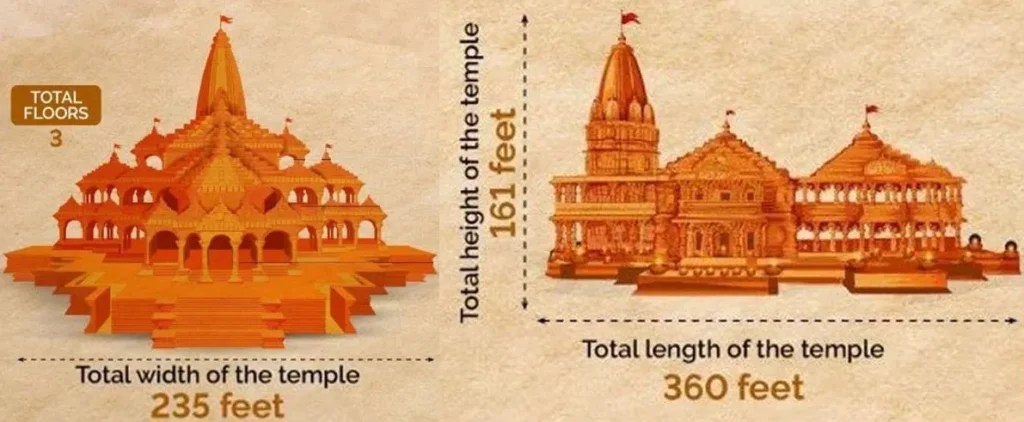
Standing on 2.7 acres of land in the temple town, the temple is 161 feet tall, 235-250 feet wide (approx.), and has a total length of 360-380 feet (approx.). The built-up area of the temple is nearly 57,000 square feet and is a three-floor structure. The height of the temple is about 70% of that of the Qutab Minar.
Concept : A Fusion of Styles
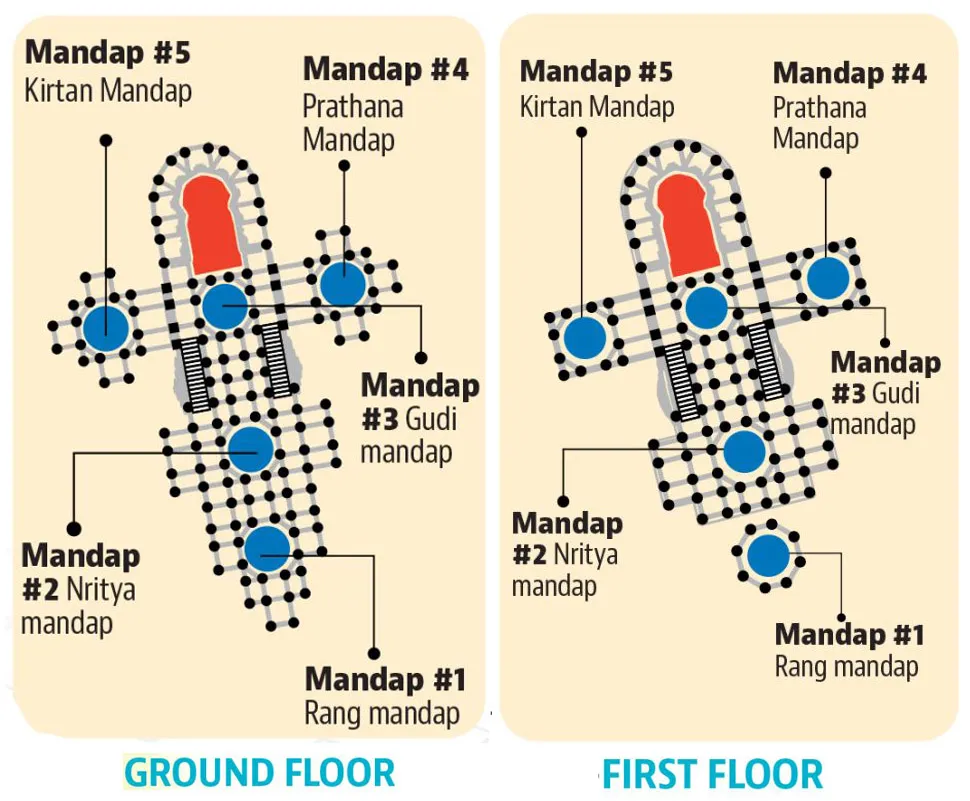
Chandrakant Sompura’s design for the Ram Mandir combines the Nagara style with Vastu Shastra principles. Featuring a Gopuram-style eastern entrance, reminiscent of southern temples, and walls adorned with artworks depicting Lord Ram’s life, the temple is a blend of regional architectural traditions.
What is Nagara Style ?
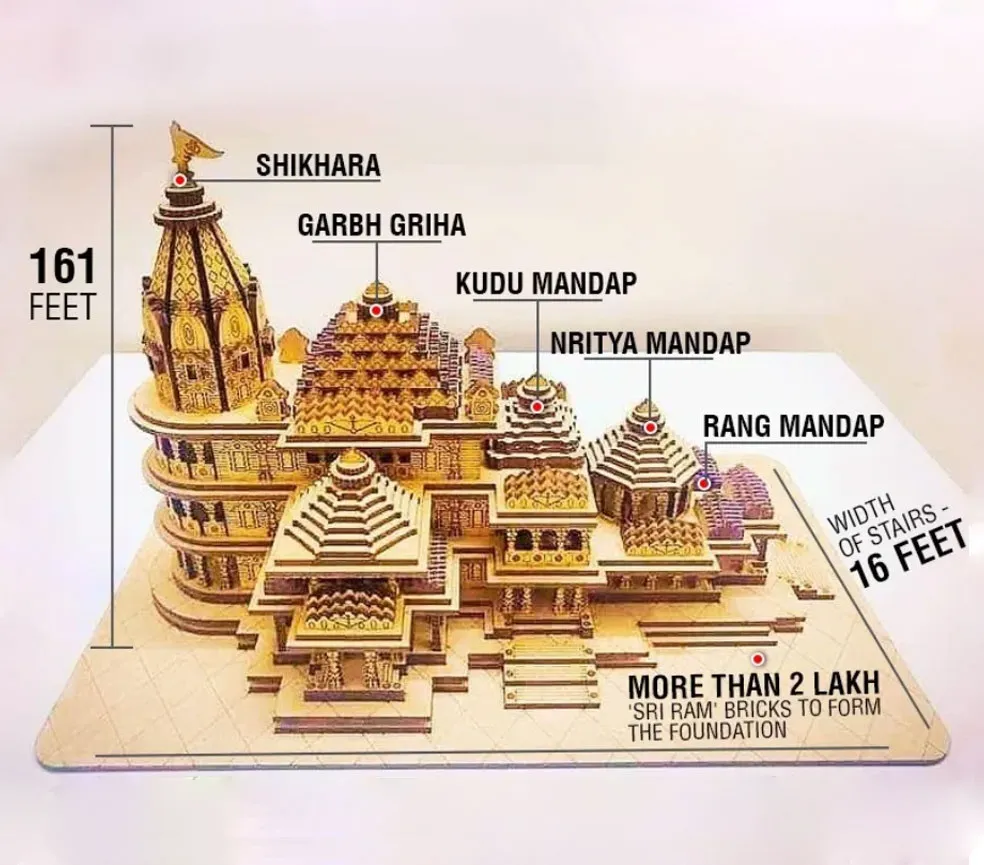
In the Gupta period, as the Nagara style developed, temples were built mainly with stone and brick. The use of iron or steel was not prevalent in temple construction at this time. The focus was more on the artistic and aesthetic aspects of temple architecture rather than on using metal reinforcements or structures.
Why the Ram Mandir Avoids Iron and Steel ?
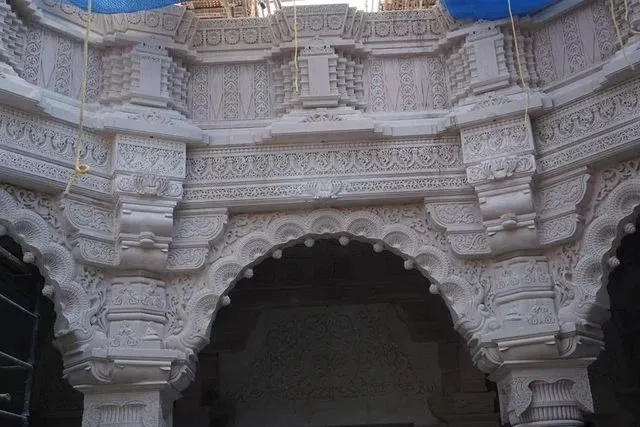
The Ram Mandir shuns iron and steel, favoring granite, sandstone, and marble with an innovative lock and key design. This approach, avoiding cement or mortar, promises a remarkable lifespan of up to 1,000 years, far exceeding iron’s 80-90 year durability.
Scientist Created – Surya Tilak Mirror
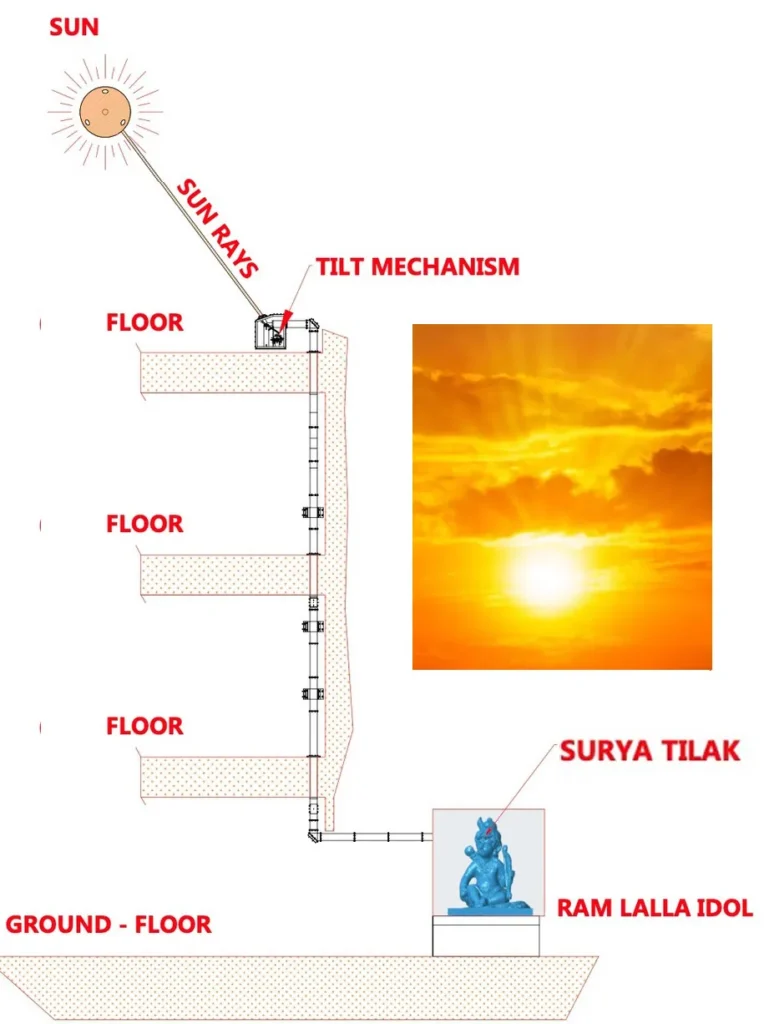
A team of scientists from CBRI and IIA created the ‘Surya Tilak’ mirror, a lens-based apparatus, for the ceremonial anointment of Lord Ram on Ram Navami, using sunlight on the idol’s forehead at noon.
Diverse Stones, Divine Artistry
Crafted with distinction, the temple showcases pristine white Makrana marble from Rajasthan at its heart. Exquisite deity idols emerge from Karnataka’s Charmouthi sandstone, while the grand entrance features Rajasthan’s pink Bansi Paharpur sandstone. Completing this symphony of stones, Lord Ram’s idol is sculpted from Karnataka’s elegant black stone.
Unity Through Craftsmanship
The Temple unites India’s diverse heritage, Intricately carved wooden doors and handcrafted fabrics from Arunachal Pradesh and Tripura adorn its entrance. Brassware hails from Uttar Pradesh, while polished teakwood has been sourced from Maharashtra.
Why Bansi Paharpur Sandstone ?
Selected for the Ram Mandir’s superstructure, the Bansi Paharpur Sandstone from Rajasthan’s Bharatpur District is
celebrated for its unique pink hue, durability, and beauty. It will require a total of 4 lakh sq ft of stone. this sandstone is a staple in India’s grand architecture, gracing landmarks like the Akshardham Temple, Parliament Complex, and Agra’s Lal Quila.
Teak Wood – Doors & Windows
Teak wood, sourced from Maharashtra’s Chandrapur, is being used to construct the doors and windows. Known for its exceptional durability, Teak boasts a lifespan of over 100 years.
2) Architectural Elements of Ayodhya Ram Mandir
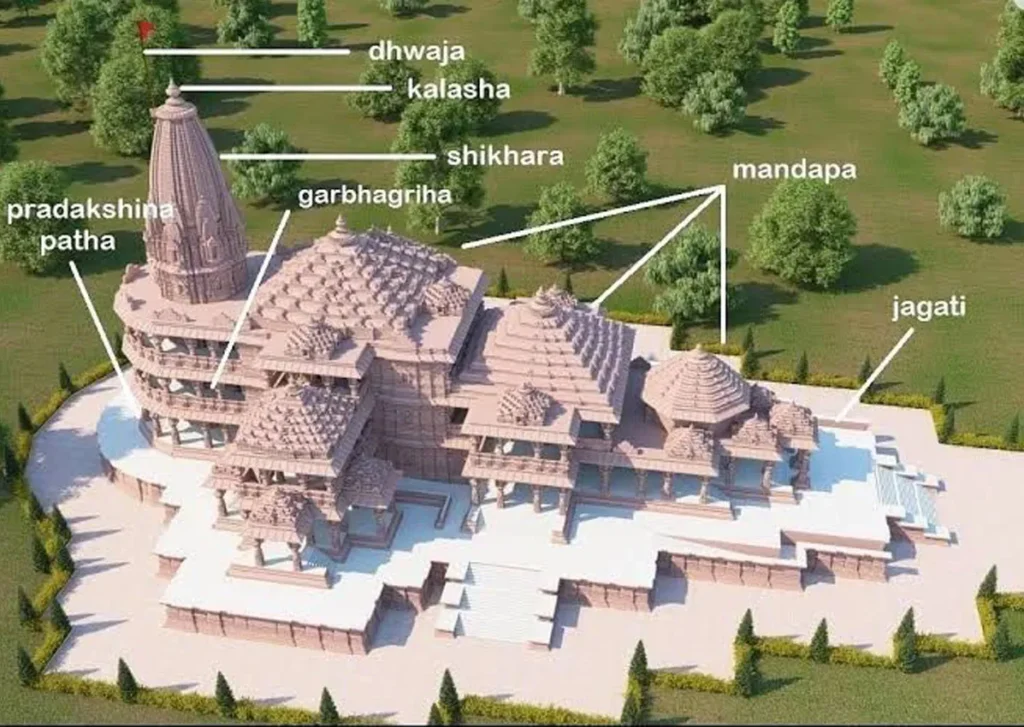
i) Shikhara (Tower):
- Description: The towering spire or shikhara is a prominent feature of the Ayodhya Ram Mandir. It is characterized by intricate carvings and detailed ornamentation.
- Influence and Style: The shikhara draws inspiration from North Indian temple architecture, particularly the Nagara style. Its verticality symbolizes the connection between earthly and divine realms.
- Significance: The shikhara represents the abode of the deity, reaching towards the heavens. It is a visual manifestation of the transcendence of the divine.
ii) Mandapa (Hall):

- Description: The mandapa is a pillared hall used for congregational worship and gatherings. It often features ornate pillars adorned with carvings.
- Influence and Style: The mandapa design is rooted in classical Indian architecture. Its structure is influenced by both the Nagara and Dravida styles, showcasing a synthesis of regional influences.
- Significance: The mandapa serves as a communal space for devotees to assemble and participate in religious rituals. Its pillars often depict mythological narratives.
Featuring five majestic shikharas atop, this site boasts five intricately designed mandapas, supported by 300 pillars. Enhancing the structure are 44 elegant teak doors. The complex includes the Keertan Mandap, Nritya Mandap, Rang Mandap, and two Prarthana Mandaps, each presenting an open area layout.
iii) Garbhagriha (Sanctum Sanctorum):

- Description: The garbhagriha is the innermost sanctum where the main deity’s idol is enshrined. It is a sacred space that represents the core of the temple.
- Influence and Style: The garbhagriha design aligns with the Nagara style, emphasizing verticality and intricate ornamentation. The entrance may have a shikhara or a distinct form of decorative arch (torana).
- Significance: The garbhagriha symbolizes the divine presence of the deity. Devotees offer prayers and worship, focusing on the sanctity of this inner chamber.
The temple, features five mandapas and a majestic tower across its three floors. At its heart lies the Garbh Griha, ingeniously designed to let sunlight bathe the idol of Ram Lalla, the infant form of the Lord, enhancing the sanctity of the Garbha Griha Mandap.
iv) Mandir Campus and Peripheral Structures:
- Description: The temple complex includes various peripheral structures like prakara (enclosure walls) and gopurams (ornate entrance towers).
- Influence and Style: The layout of the temple campus draws inspiration from traditional Hindu temple architecture. Gopurams, in particular, exhibit Dravida influences with intricate sculptures and towering structures.
- Significance: The temple complex symbolizes a sacred and enclosed space, separating the divine realm from the secular world. Gopurams often depict scenes from Hindu epics and serve as monumental gateways.
v) Sculptures and Carvings:
- Description: The Ayodhya Ram Mandir is adorned with elaborate sculptures and carvings depicting scenes from the Ramayana, various deities, and mythological narratives.
- Influence and Style: The sculptural elements reflect a blend of local and classical styles, showcasing the rich artistic heritage of Indian temple architecture.
- Significance: Sculptures narrate religious stories, impart moral teachings, and serve as a visual means to connect devotees with the divine. Each carving holds symbolic significance within Hindu iconography.
Dual Idols of Lord Ram
Two Lord Ram idols will be present: one discovered in 1949 and kept in a tent for decades, and the other will be a huge statue which will be visible from a long distance.
New Idol of Ram Lalla
A captivating 51-inch black stone idol of Lord Shri Ram Lalla, resembling a five-year-old child, has been meticulously sculpted by Arun Yogiraj. It will be placed on the ground floor of the three-story temple.
Ram hi Ram Everywhere..
Over 30 years, nearly two lakh bricks, inscribed with Lord Ram’s name in various languages, are being incorporated into the temple.
vi) Yajna Shala (Fire Pavilion):
- Description: Some temples incorporate a yajna shala or fire pavilion for ritualistic ceremonies, especially during special occasions.
- Influence and Style: The yajna shala may have Vedic influences and is designed to accommodate sacred fire rituals.
- Significance: It provides a designated space for performing religious ceremonies and yajnas, reinforcing the Vedic traditions associated with Hindu temple worship.
In conclusion, the Ayodhya Ram Mandir’s architectural elements reflect a harmonious blend of traditional Indian temple styles, showcasing the diversity and richness of Hindu temple architecture. Each component serves a specific purpose, contributing to the spiritual and aesthetic experience of devotees while preserving the cultural and historical identity of the sacred site.
3) Intricate Sculptures and Carvings of Ayodhya Ram Mandir
i) Depiction of Lord Rama’s Life:
- Description: Elaborate carvings depict scenes from the life of Lord Rama as narrated in the Ramayana. This includes his birth, childhood, marriage, exile, and triumphant return.
- Symbolic Meaning: These carvings symbolize the divine narrative of Lord Rama, emphasizing virtues such as duty (dharma), righteousness, and devotion. Devotees find spiritual inspiration through visual storytelling.
ii) Rama’s Coronation:
- Description: Intricate carvings capture the moment of Lord Rama’s coronation, known as the ‘Rama Rajabhishek.’
- Symbolic Meaning: The coronation scene symbolizes the establishment of dharma and righteous governance. It signifies the ideal rule of Lord Rama, inspiring devotees to strive for virtuous leadership and just governance.
iii) Hanuman and the Bridge to Lanka:
- Description: Carvings depicting Hanuman carrying the mountaintop with the sacred herb to heal Lord Lakshmana and the construction of the bridge to Lanka.
- Symbolic Meaning: These carvings symbolize Hanuman’s unwavering devotion and selfless service to Lord Rama. The bridge-building scene represents the triumph of good over evil and the power of collaborative efforts in the pursuit of righteousness.
iv) Sita Swayamvar:
- Description: Intricate carvings illustrating the Swayamvar ceremony where Sita garlands Lord Rama, choosing him as her husband.
- Symbolic Meaning: This scene symbolizes the purity of love, virtue, and the divine union of Lord Rama and Sita. It reinforces the values of loyalty, commitment, and the sacred bond between husband and wife.
v) Lakshmana Rekha:
- Description: Carvings portraying the moment when Lakshmana draws the protective line around Sita’s dwelling during Lord Rama’s absence.
- Symbolic Meaning: The Lakshmana Rekha symbolizes the importance of boundaries, loyalty, and the commitment to protect loved ones. It is a visual representation of the duty-bound nature of Lakshmana.
vi) Garuda and Nandi Sculptures:
- Description: Sculptures featuring Garuda, the mount of Lord Vishnu, and Nandi, the sacred bull associated with Lord Shiva.
- Symbolic Meaning: Garuda symbolizes divine protection, while Nandi represents devotion and steadfastness. Both sculptures signify the harmonious coexistence of different deities within the sacred space of the temple.
vii) Navagrahas (Nine Planets):
- Description: Carvings representing the Navagrahas, the nine celestial bodies in Hindu astrology, often found in the temple’s architecture.
- Symbolic Meaning: These carvings signify the cosmic order and the influence of celestial bodies on human life. Devotees seek blessings for auspiciousness and protection from malefic planetary influences.
viii) Makara Toranas:
- Description: Makara-shaped arches or toranas featuring mythical aquatic creatures often embellish the temple’s entrances.
- Symbolic Meaning: The Makara symbolizes the cosmic ocean and the cycle of life. Toranas signify auspiciousness and act as gateways between the earthly and divine realms, inviting devotees into the sacred space.
In essence, the intricate sculptures and carvings around the Ayodhya Ram Mandir not only showcase exquisite craftsmanship but also serve as powerful visual narratives that reinforce the values, virtues, and divine stories embedded in Hindu mythology. Each carving contributes to the spiritual ambiance of the temple, creating a sacred space that resonates with cultural and religious significance.
4) Religious Importance of Ayodhya Ram Mandir for Hindus
i) Birthplace of Lord Rama:
- Significance: The Ayodhya Ram Mandir holds immense religious importance as it is believed to be the exact birthplace of Lord Rama, the seventh avatar of Lord Vishnu.
- Religious Connection: For Hindus, Lord Rama is a revered deity who embodies ideals of dharma (righteousness), devotion, and virtue. The temple, situated at this sacred spot, becomes a pilgrimage site for millions seeking to connect with the divine.
ii) Spiritual Symbolism:
- Significance: The temple is considered a symbol of spiritual awakening and cultural resurgence.
- Religious Connection: Its reconstruction and existence signify the revival of a sacred site and reinforce the spiritual identity of Ayodhya, resonating with the religious sentiments of the Hindu community.
iii) Role in Religious Ceremonies:
- Significance: The Ayodhya Ram Mandir plays a central role in various religious ceremonies and rituals.
- Religious Connection: From daily worship (puja) to special ceremonies and festivals, the temple serves as a focal point for religious activities, providing devotees with a place to express their devotion and connect with the divine.
iv) Festivals Celebrated at the Temple:
- Significance: The temple becomes a vibrant center of celebration during Hindu festivals.
- Religious Connection: Festivals such as Ram Navami, which commemorates Lord Rama’s birthday, witness grand celebrations at the Ayodhya Ram Mandir. Devotees gather to participate in special prayers, processions, and cultural events, fostering a sense of community and devotion.
v) Pilgrimages to Ayodhya:
- Significance: The Ayodhya Ram Mandir is a prominent pilgrimage destination for Hindus.
- Religious Connection: Pilgrims from various parts of India and beyond visit Ayodhya to seek blessings at the sacred site associated with Lord Rama. The pilgrimage to Ayodhya is considered an essential spiritual journey for devout Hindus, offering an opportunity for religious introspection and divine communion.
vi) Reverence for the Sanctum Sanctorum:
- Significance: The garbhagriha (sanctum sanctorum) of the temple holds special religious significance.
- Religious Connection: Devotees consider the innermost chamber as the abode of the deity, and offering prayers in this sacred space is believed to bring blessings, protection, and spiritual upliftment.
vii) Cultural Identity and Unity:
- Significance: The Ayodhya Ram Mandir contributes to the cultural identity of Hindus.
- Religious Connection: The temple serves as a unifying force, fostering a sense of shared cultural heritage and religious identity among Hindus. It stands as a testament to the endurance of faith and the cultural continuity of a sacred site.
viii) Ceremonial Consecration and Rituals:
- Significance: The consecration ceremony (pran pratishtha) and regular rituals contribute to the sanctity of the Ayodhya Ram Mandir.
- Religious Connection: Ceremonies conducted by priests involve the invocation of divine presence, purifying the temple and making it a sacred space for religious practices. Regular rituals, including aarti (ceremonial worship with light), enhance the spiritual atmosphere.
In conclusion, the Ayodhya Ram Mandir holds profound religious importance for Hindus, serving as a spiritual haven, a cultural symbol, and a pilgrimage destination that fosters a sense of community and devotion among millions of believers. Its role in religious ceremonies, festivals, and pilgrimages is integral to the vibrant tapestry of Hindu religious and cultural traditions.
5) Cultural Impact of Ayodhya Ram Mandir on Ayodhya and Indian Society
i) Revival of Cultural Heritage:
- Impact: The construction of the Ayodhya Ram Mandir has led to the revival of Ayodhya’s cultural heritage, contributing to the restoration of its historical and religious significance.
- Contribution: The temple serves as a cultural symbol, connecting Ayodhya to its ancient roots and reinforcing the city’s identity as a center of religious and cultural importance.
ii) Cultural Unity and National Identity:
- Impact: The Ayodhya Ram Mandir acts as a unifying force, bringing people from diverse cultural backgrounds together.
- Contribution: It contributes to the broader Indian narrative, fostering a sense of national identity by highlighting shared cultural and religious values.
iii) Religious Tourism and Cultural Exchange:
- Impact: The temple has become a major religious tourism destination, attracting visitors from across India and around the world.
- Contribution: This influx of pilgrims and tourists fosters cultural exchange, creating a vibrant cultural atmosphere as people from different regions come to Ayodhya to pay homage to Lord Rama.
iv) Promotion of Traditional Arts and Crafts:
- Impact: The reconstruction of the temple has provided a platform for traditional artisans and craftsmen.
- Contribution: Skilled craftsmen involved in the project have showcased traditional arts and crafts, preserving and promoting India’s rich cultural heritage.
v) Festivals and Cultural Celebrations:
- Impact: The Ayodhya Ram Mandir has become a focal point for cultural celebrations and festivals.
- Contribution: Festivals such as Ram Navami and other religious and cultural events bring communities together, fostering a sense of shared identity and celebration.
vi) Educational and Cultural Awareness:
- Impact: The construction process and subsequent events have increased awareness about the cultural and historical significance of Ayodhya.
- Contribution: Educational initiatives and cultural programs centered around the temple contribute to the dissemination of knowledge about the region’s rich heritage.
vii) Symbolic Importance in Popular Culture:
- Impact: The Ayodhya Ram Mandir has become a symbol in popular culture, featuring prominently in literature, music, and art.
- Contribution: Its representation in various forms of media contributes to the perpetuation of its cultural significance and embeds it further into the collective consciousness.
viii) Cultural Diplomacy:
- Impact: The Ayodhya Ram Mandir has the potential to play a role in cultural diplomacy, fostering connections and collaborations with cultural institutions worldwide.
- Contribution: Its cultural prominence can serve as a gateway for showcasing India’s cultural diversity and fostering cultural exchanges on an international level.
In summary, the Ayodhya Ram Mandir has a profound cultural impact, not only in Ayodhya but across Indian society. It contributes to the cultural identity of the region by reviving historical heritage, fostering cultural unity, promoting traditional arts, and serving as a symbol of shared values and religious beliefs. The temple has become a living testament to the enduring cultural legacy of Ayodhya and India as a whole.
6) Summary of Key Points
The article provides a comprehensive overview of the Ayodhya Ram Mandir, covering historical evolution, architectural elements, cultural impact, and practical aspects for visitors. Here are the key points discussed:
Historical Evolution
- Ayodhya’s ancient roots and significance in Hindu mythology.
- The historical phases of the Ram Mandir, from ancient times to the present day.
- Notable events including construction, destruction, and reconstruction.
Architectural Elements
- Detailed exploration of the temple’s architectural components.
- Influence of traditional styles like Nagara and Dravida.
- Significance of structures like the shikhara, mandapa, and garbhagriha.
Sculptures and Carvings
- Intricate carvings depicting scenes from Lord Rama’s life.
- Symbolic meanings behind sculptures, emphasizing cultural and religious narratives.
- Cultural richness conveyed through visual storytelling.
Religious Importance
- Ayodhya’s significance as Lord Rama’s birthplace.
- The role of the temple in religious ceremonies, festivals, and pilgrimages.
- The temple’s place in Hindu culture, serving as a spiritual hub.
Cultural Impact
- Revival of Ayodhya’s cultural heritage.
- Contributions to cultural unity, national identity, and cultural diplomacy.
- Symbolic importance in popular culture, literature, music, and art.
Reinforcing Significance
The Ayodhya Ram Mandir stands as a symbol of India’s historical and cultural tapestry. In both historical and contemporary contexts, the temple serves as a unifying force, connecting people to their roots, fostering cultural pride, and contributing to the collective identity of the nation.
Its reconstruction not only preserves a sacred site but also revitalizes Ayodhya’s cultural heritage, making it a beacon of spirituality, cultural resilience, and unity for generations to come. The temple’s significance extends beyond religious boundaries, embodying a timeless connection between the ancient past and the vibrant present.